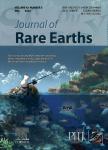Synthesis and photoluminescence properties of Ca_3R_(2–x)WO_9:xEu^(3+)(R=Y, Gd) phosphors
Synthesis and photoluminescence properties of Ca_3R_(2–x)WO_9:xEu^(3+)(R=Y, Gd) phosphors作者机构:Department of Chemistry Ningde Normal University School of Chemistry and Pharmaceutical Sciences Guangxi Normal Univer-sity College of Chemistry and Chemical Engineering Fuzhou University
出 版 物:《Journal of Rare Earths》 (稀土学报(英文版))
年 卷 期:2015年第33卷第2期
页 面:135-139页
核心收录:
学科分类:081702[工学-化学工艺] 0709[理学-地质学] 0819[工学-矿业工程] 08[工学] 0817[工学-化学工程与技术] 0708[理学-地球物理学] 0703[理学-化学]
基 金:Project supported by the Fujian Provincial Department of Education Project(JA13331)
主 题:tungstate rare earth luminescence LED
摘 要:Ca3R2–xWO9:xEu^3+(R=Y, Gd) red-emitting phosphors were prepared by solid state reactions. These samples were characterized by differential scanning calorimetry and thermogravimetry analysis(DSC-TGA), X-ray diffraction(XRD), Fourier transform infrared spectroscopy(FTIR), photoluminescence(PL) and field emission scanning electron microscopy(FE-SEM) analyses. The optimum sintering temperature for these phosphors was 1100 ℃, and the optimum sintering time was 2 h. The optimum doped concentration of Eu^3+ in Ca3Y2–xWO9:xEu^3+ and Ca3Gd2–xWO9:xEu^3+ were x=1.5 and x=1.1, respectively. These phosphors could be excited by near-UV light of 394 nm and blue light of 465 nm, and showed strong red emission line at 612 nm(^5D0→^7F2), which indicated that Ca3R2–xWO9:xEu^3+(R=Y, Gd) were promising red candidates for white LED.



